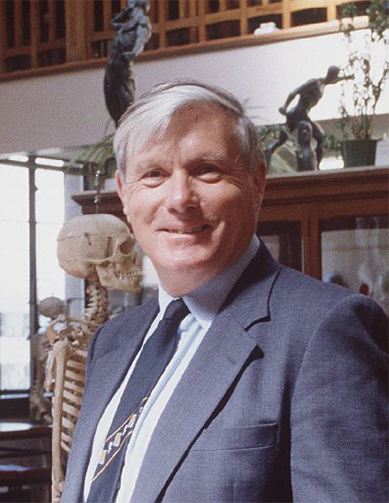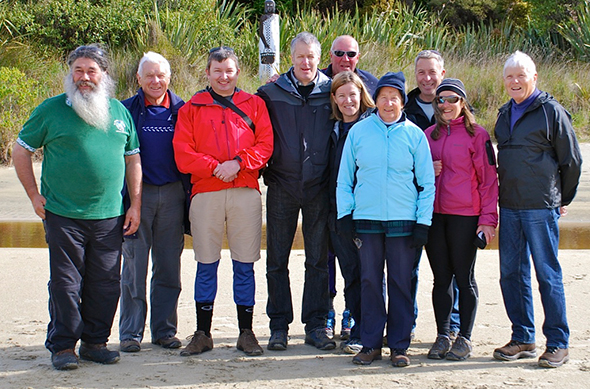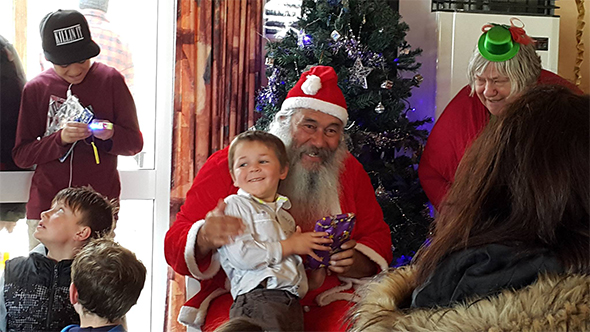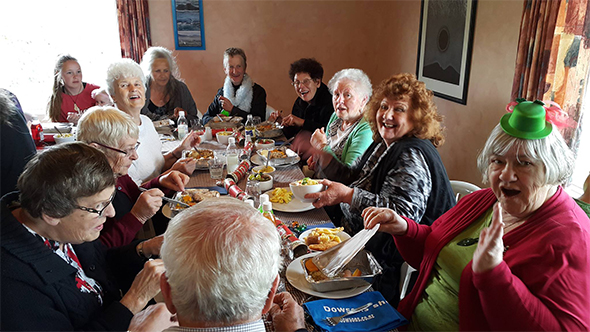Ngā mate
Ralph David Huston Stewart – Emeritus Professor of Medicine
The foundations of David Stewart’s professional and academic achievements during more than 60 years in medicine were laid in early life.
His father, Ralph Stewart, was completing his postgraduate medical training at Christchurch Hospital in 1931 when he met and married Mary Bar Stevenson, who was then finishing her nursing training and the first of her family to go to university.
Ralph was a graduate of Trinity College Dublin and both his father and grandfather had pursued intellectual and academic careers in Ireland.
Mary was descended on her mother’s side from Marta Te Wharerimu and Robert Brown, who were prominent in the sealing settlement on Whenua Hou (Codfish Island) from 1825; and on her father’s from many New Zealand generations of high country pastoral and estate managers. There are Stevenson family roots at Braemar Station, West Wānaka Station and Henley Estate, and, Stevenson’s Arm on Lake Wānaka is named after her grandfather.
Throughout his life, Prof Stewart felt a strong connection to his Irish, Pākehā and Ngāi Tahu heritage. He and his identical twin, John, were born in 1933 in England, where his father had returned to establish himself as a successful general practitioner. In those days GPs saw patients and dispensed medicines from a surgery at their home or conducted home visits and the young David and John spent many hours loitering around the surgery door trying to diagnose illnesses from the medicine bottle patients emerged with or information gleaned from overheard conversations.
As can be imagined, their parents were not always pleased with this early curiosity about medicine and were no doubt pleased when the boys started their education with other local children at the Eton Headmaster’s House. In 1939, Ralph died after a short illness and a devastated Mary (who had also lost her 2 year-old daughter Beverley in 1936) brought the boys back to her home town of Timaru, where they spent most of the war years until Mary’s marriage to Jack Fraser, the run holder at Dusky Station on the shores of Lake Pūkaki.
The twins’ lives were transformed by the move to a high country sheep station and by gaining a stepfather who was strict, kind, practical and sensed the potential of the two sheltered, naive ‘townies’ for whom he accepted a father’s responsibility.
The boys started at Waitaki Boys’ High School as boarders in 1944. In those days, boarding conditions at Waitaki were spartan and discipline strict but David and John survived and ultimately prospered, despite being, or perhaps partly because they were in their first year – the youngest and smallest boys there.
They benefitted directly from two great headmasters, Frank Milner and Jim Burrows, and from the teaching style which emphasised a broad understanding of the subject matter rather than accumulation of knowledge. It was at Waitaki that David and John became intellectually inspired and began to develop their scholarly aptitude and discipline before both going to Otago University to study medicine.
The brothers spent the five years at Otago as residents at Knox College. David served on the college students’ council and as president of the medical students’ association; he represented the university in athletics and rugby, gaining a blue for athletics; and in 1956 he graduated top of the year with the senior scholarship in medicine.
Most university holidays were spent working on John Aitken’s sheep station, Loganbrae, at Paerau.
In those years, the Otago medical course provided less factual knowledge than those in Britain but the sound grounding in the principles of medical science and careful instruction in clinical skills ensured their graduates could rise to the challenges of the hospital resident years and postgraduate training programmes.
While at Otago, Prof Stewart met future wife Dorothea Gibbs (née Doff) on a skiing holiday at Coronet Peak just a few weeks after her 21st birthday. She was the daughter of deeply religious and intellectual Wellington businessman, Theo Gibbs and his wife, Elsie.
The discussions around the dining table, conversation pit and on many family holidays with the extended Gibbs family were an important influence on Prof Stewart’s thinking about how good business principles and practices sat comfortably with public institutions, academic achievement and a life of public service.
The couple were married in Ōtaki in 1957 and were each other’s best friend, soul mate, companion and support for nearly 60 years, initially in Wellington, then London, Birmingham, Dundee, Sydney, Dunedin and Lake Hayes. They started their family with the birth of Ralph (1958) in Wellington, then Sara (1960) and Hamish (1962) in London and Timothy (1965) in Sydney. The Stewarts were both accomplished bridge players, keen skiers, golfers and sailors, activities which filled their holidays and leisure time along with a shared interest in reading, history and political thought. Their love of both dinghy sailing and skiing were key reasons for buying holiday houses on the edge of Lake Hayes in the early 1970s which have been the much loved holiday homes for the extended family ever since and became their happy retirement home towards the end of their lives.
“We will always remember hiking up the Routeburn with David and Doff and staying in the Flats hut,’’ said two of their youngest grandchildren, Libby and Pippa.
“And David inventing cornflakes in orange juice. He always made us laugh, he gave us difficult questions that we loved, and he was never afraid to speak his mind.’’
A few short weeks after Doff’s 81st birthday, they moved to Edmund Hillary Retirement Home in Auckland, where they could remain together and where Doff continues to live.
As for his medical career, Prof Stewart had two years as a house surgeon in Palmerston North and Wellington, then four years postgraduate training in Britain studying thyroid physiology and disease, at the Courtauld Institute of Biochemistry, Middlesex Hospital, London, general endocrinology at the Postgraduate Medical School and general medicine at Birmingham, London and Dundee. This was followed by eight years at the University of New South Wales in the thyroid unit at Prince of Wales Hospital as lecturer in Medicine and Honorary Physician.
During his time in Sydney he also undertook his only period in private medical practice, setting up a diagnostic service in nuclear medicine, then a new specialty.
In his post-graduate years, Prof Stewart was awarded honours including Member of Royal College of Physicians (London), Member of Royal Australasian College of Physicians, Doctor of Medicine (Otago), Fellow of Royal Australasian College of Physicians and Fellow of Royal College of Physicians (London). He was invited back to the Otago Medical School, initially as Associate Professor of Medicine, Director of Nuclear Medicine, and Endocrinologist from 1971-74.
During this time his close collaboration materially contributed to Duncan Adams’ elucidation of the autoimmune pathogenesis of thyrotoxicosis, which was difficult and dangerous to treat without that knowledge. By 1974 he had made his mark as a teacher, clinician and an expert in thyroid disease and was promoted to the Mary Glendinning Chair of Medicine and Head of Department of Medicine which he held until 1982, to Sub Dean (1983), then Dean of Medicine (1986-95) and Assistant Vice Chancellor of Health Sciences (1991-99).
As AVC he employed his strategic vision and negotiating skills to lead improvements in the level of cooperation between the medical and other schools in the division, modernise the first-year courses leading to admission to health science courses, recruit full fee-paying foreign medical students to Dunedin and introduce three new degree courses: Bachelor of
Physiotherapy, Bachelor of Medical Laboratory Science, and Postgraduate Diploma in Public Health.
It was in his last three chiefly administrative posts Prof Stewart switched his attention from the immediate responsibilities of running large university and hospital departments to the wider issues surrounding the restructure of medical education and health service delivery made necessary in the mid-1980s by an ageing population, increasing costs, advances in knowledge and technology and changed public attitudes and expectations. During these years he also continued his clinical practice as a specialist endocrinologist.
Other significant career appointments included: member of the Fact-Finding Committee on Nuclear Power Generation (1975), Member Review of Cancer Research in NZ (1982), Appointed Member Otago Hospital Board (1984-89 and 2001-07), vice-chairman Senate University of Otago (1985-87), Member Workforce Advisory Committee Dept of Health(1986-89), Director Ashburn Hall (1986-91), chairman of review of funding of Medical Research in NZ (1988-89), elected member of Council University of Otago (1991-94), chaired review of funding of clinical training for health professionals (1992), member National Interim Provider Board (1992), chaired Steering Committee Crown Health Enterprises Establishment Unit (1992-93), chaired Clinical Advisory Group CHE Monitoring Unit (1993-94), director of Healthlink South (1996-99), director of HealthCare Otago (1998-2000), chaired Hospital Advisory Committee, Otago DHB (2002-07), member Hospital Advisory Committee, Southland DHB (2002-07), member Health Workforce Taskforce (2006-07) and director of Southern Community Laboratories (2007-11). In 1990, Prof Stewart was awarded the NZ Commemoration Medal for services to New Zealand. He was also Endocrine Society of Australia Member of Council (1967-69), Royal Australasian College of Physicians Member Accreditation Board for New Zealand (1974-78), chairman of Accreditation Board for New Zealand (1978-80), member New Zealand Committee (1978-80), member of Council (1978-80), New Zealand Society of Endocrinology President (1985-88), honorary Life Member (1999-2001) and Medical Council of New Zealand Member of Council (1991-92) and chairman of Medical Education Committee (1991-92).
Prof Stewart retired from the university in 1999 and from his administrative roles in the health sector between 2000 and 2007. He continued to conduct twice weekly endocrine clinics with the endocrine department under Patrick Manning until 2011, which gave him great pleasure as it was the first time in many years he could simply practise medicine and be part of a medical team.
During his final months in Auckland, he continued to take a great interest in the world around him through the TV. He summoned the energy for long conversations about the state of the world, the imbalances of wealth, the many different aspects of his life, and what was going on in the lives of those close to him. Prof Stewart, who died in Auckland in November aged 82, is survived by Dorothea, children Ralph, Sara, Hamish and Tim and many grandchildren.


Whānau during a trip to Whenua Hou in 2011. David is on the far right.
Kia ora whānau, we hope that you all had an enjoyable Christmas break and were able to spend time with whānau and friends over this period. Hopefully you are now feeling energised and ready to meet the challenges of 2016.
With the varied weather we have experienced over the summer, the last two weeks have been a welcome bonus especially so over Waitangi Weekend. This weather has been a boon for holidaymakers and it has been wonderful to see so many people out swimming, surfing, floundering, fishing and enjoying the beautiful beaches in our rohe.
Over the next month we look forward to hosting Te Rūnanga o Ngāi Tahu general hui at Te Kōawa Tūroa o Takitimu. The preparations have been ongoing and whānau have been working hard both behind the scenes and at the working bee in the lead-up to this hui. Many thanks to whānau who have given freely of your time so far and to those who will be working during the course of the hui.
If you have enjoyed a birthday in the last month or have new additions to your whānau, congratulations and here is wishing you all good health and prosperity for the year ahead.
There are some exciting opportunities for whānau coming up over the next few months including a series of water monitoring hīkoi. Water truly is our most precious resource and it is vitally important that our decision-making regarding this resource takes account of the needs of our future generations. See article underneath for more information.
General monthly meetings
The general monthly meetings as a rule take place Takutai o Te Tītī Marae on the second Sunday of each month. The dates for 2016 are as follows:
- 13 March
- 10 April
- 8 May
- 12 June
- 10 July
- 14 August
- 11 September
- 9 October (AGM)
- 13 November.
All members are welcome to attend the general meetings, so please feel free to come along and find out what is happening. If for any reason these dates change we will notify whānau as soon as possible.
Whānau Christmas party
The whānau Christmas party took place Takutai o Te Tītī Marae On Sunday 13 December 2015 at 11.00am. Despite the inclement weather a great day was had by those who attended and hana koko even took the time to pay us a visit. Thanks to Ron Bull and his helpers for the awesome hāngī and to all the others who helped prepare the kai and gave their time to make this a memorable whānau day.

Hana Kōkō with some of our excited tamariki.

The kaumātua enjoying their kai.
Volunteers
We are always looking for volunteers to help out with the various projects and commitments we have. There are many diverse roles that we need help with, some of which include: representation on boards or appointment panels, helping with bird transfers, assisting at the marae or working in the nursery or wetlands – and many more. If you are keen to play a more active role within the rūnaka please contact us here at the office to discuss the options.
Communication with whānau
We are looking at ways to improve our communications with whānau and as such we are exploring different mediums to get the word out there about what is going on. Generally, we are seeking to limit the volume of email traffic we generate.
One of the things we have done is create an opportunities page on Facebook. This page will carry details of any opportunities for our members such as details of scholarships, bird transfers, vacancies for representatives on various boards and much more. The link below will take you to this page.
http://www.facebook.com/OrakaAparimaRunakaPanui
https://www.facebook.com/pages/Oraka-Aparima-Runaka-opportunity-pages/1615071675378752
In the interim we will continue to send you emails, however if you no longer wish to receive them please let us know.
Contact details
As indicated above we want to improve our communication with whānau. In order to help us with this, could you please ensure that you keep all your contact details up-to-date. If you have recently started using email or changed address or your internet provider please let us know your details, so we can add or amend them on our distribution list. To contact us via Facebook please follow the link above.
Pānui contributions
We welcome contributions from whānau for Te Pānui Rūnaka. If you wish to contribute please send your news and stories to us at: [email protected] or phone 03 234 8192. We now have an 0800 number – 0800 234 8192.